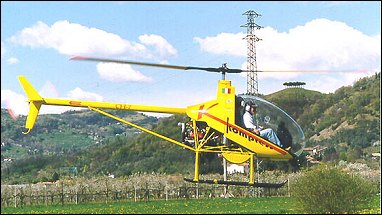
| Helisport CH-7 "Kompress" 1992 |  |
 |

| Helisport CH-7 "Kompress" 1992 |  |
 |
|
Previously known as EliSport, the company markets the Kompress, a development of the CH-6 produced in 1987 by the Argentine designer Augusto Cicare. US agent is Lancair. HeliSport CH-7 Kompress two-seat light helicopter HELISPORT CH-7 KOMPRESS TYPE: Two-seat ultralight helicopter kitbuilt. PROGRAMME: CH-6 project acquired in 1989 by HeliSport; added new cockpit by sports car designer Marcello Gandini; renamed CH-7 Angel, two-seat version became Kompress. CURRENT VERSIONS CH-7 Kompress: Standard version, as described. CH-7 Mariner: Float-equipped version. Multi-tube inflatable floats add 15kg to empty weight. CH-7 Angel: Single-seat version, powered by either 47.8kW Rotax 582 UL (as Angel 582) or 59.6kW Rotax 912 UL (as Angel 912). Max take-off weight of both versions is 300kg. CUSTOMERS: Some 140 flying by 2002. Owners in Australia, Germany, Italy, South Africa, Taiwan, USA and elsewhere. COSTS: Basic kit, less engine and tax ˆ66,000 (2003). DESIGN FEATURES: Small 'penny-farthing' helicopter with two-blade, semi-rigid, teetering main and two-blade rotors; pod-and-boom fuselage; sweptback upper and lower fins, latter with tailskid. Main rotor transmission by single 10cm five-groove Goodyear belt. Main rotor has 10,000-hour life, on condition. Quoted build time 200 hours; quick-build kit 85 hours. Rotor blade aerofoil sections NACA 8-H-12 (main) and NACA 63-014 (tail); 1.5kg main rotor tip weights; max 520 rpm main, 2,808 rpm tail rotor. FLYING CONTROLS: Conventional and manual, by pushrods and bell cranks. STRUCTURE: Welded 4130 steel tube cabin frame, with nitrogen filling; glass fibre cockpit shell and Plexiglas or Lexan canopy; 2024T3 anodised aluminium alloy tailboom and landing skids. Rotor blades of composites (main) and aluminium alloy (tail). LANDING GEAR: Fixed; twin-skid type. POWER PLANT: One 84.6kW Rotax 914 piston engine. Fuel capacity 40 litres standard in all versions; additional 19 litre tank optional. Jane's All the World's Aircraft, 2004-2005
|